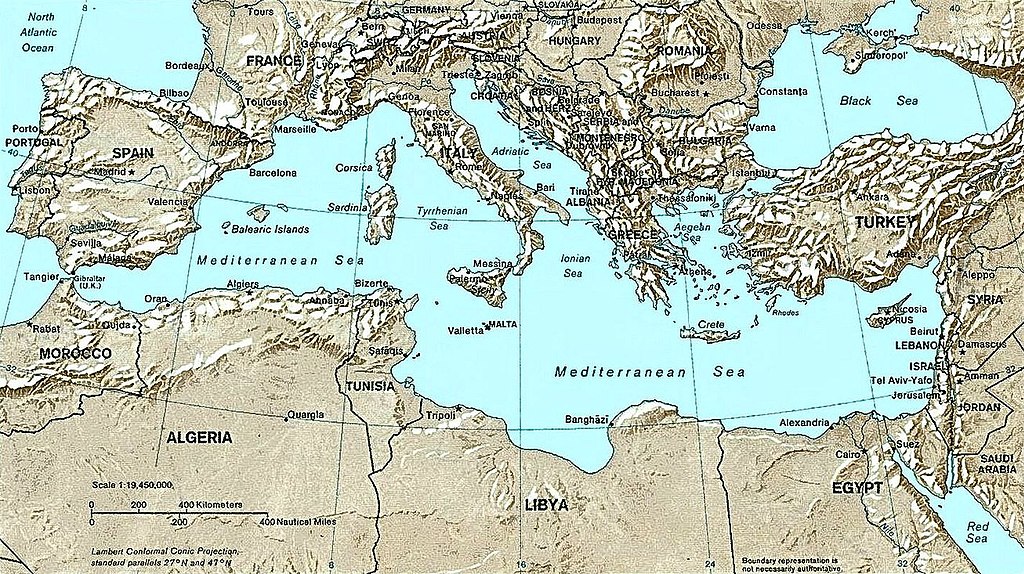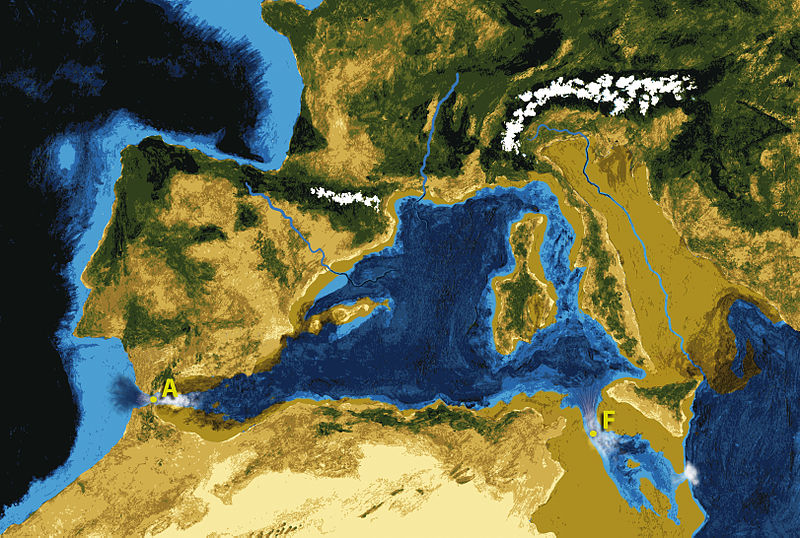I recently learned something mindblowing about the geological history of the Mediterranean Sea, and I just can't get it out of my head.
Now I'm going to make it *your* problem too. Sorry.
Hang onto your hat. This is wild.
1/
Now I'm going to make it *your* problem too. Sorry.
Hang onto your hat. This is wild.
1/

This is the Strait of Gibraltar, where Europe and Africa reach out to *almost* touch each other.
At this point there's only 13 km/ 8 miles between them - and it's where the Med feeds into the Atlantic.
Imagine if something absurdly Roland-Emmerichy happened & it closed up?
2/
At this point there's only 13 km/ 8 miles between them - and it's where the Med feeds into the Atlantic.
Imagine if something absurdly Roland-Emmerichy happened & it closed up?
2/

No need to imagine - because it actually did.
It's called the Messinian Salinity Crisis, and it happened around 5-6 million years ago:
en.wikipedia.org/wiki/Messinian…
After a presumably colossal tectonic shift, the Pillars of Hercules closed (or more correctly were bridged)....
3/
It's called the Messinian Salinity Crisis, and it happened around 5-6 million years ago:
en.wikipedia.org/wiki/Messinian…
After a presumably colossal tectonic shift, the Pillars of Hercules closed (or more correctly were bridged)....
3/
...and the Mediteranean started drying up.
After some undetermined period of time, the Mediterranean was empty - evaporated down to a desert & a series of huge, super-salty lakes.
A vast, salty desert bowl - *kilometres* deep.
(This is not the wild thing.)
4/
After some undetermined period of time, the Mediterranean was empty - evaporated down to a desert & a series of huge, super-salty lakes.
A vast, salty desert bowl - *kilometres* deep.
(This is not the wild thing.)
4/
The desert bowl of the western Med was also noticeable higher than the east.
You can see this in modern sea floor maps: shallower continental crust in the west, deeper oceanic in the east - connected at the modern-day Strait of Sicily...
And primed for another cataclysm.
5/
You can see this in modern sea floor maps: shallower continental crust in the west, deeper oceanic in the east - connected at the modern-day Strait of Sicily...
And primed for another cataclysm.
5/

Before I read about this, I assumed that at some point the Strait of Gibraltar cracked, the water rushed in, and over centuries or millennia, our modern Mediterranean was created.
That's a manageable thought, right? Epic in scale, but - thinkable.
That's not what happened.
6/
That's a manageable thought, right? Epic in scale, but - thinkable.
That's not what happened.
6/
Modern borehole and siesmic data has uncovered huge grooves through the rock on either side of the Gibraltar Strait - each around 250 metres deep...
And there's a channel along the bed of the sea floor, carved with unimaginable force.
It's around 200km long.
7/
And there's a channel along the bed of the sea floor, carved with unimaginable force.
It's around 200km long.
7/

At some point, maybe after a massive earthquake, the landlocked cliffs at the Strait were forced aside and the Atlantic rushed in with *mindboggling* fury.
Not a waterfall, but a long slope - down which roared up to *100 million cubic metres of water a second*.
8/
Not a waterfall, but a long slope - down which roared up to *100 million cubic metres of water a second*.
8/
I'm keeping the nerdy geological details pretty light here. There's so much, and it's all on an incredible, mindbending scale.
If you want to geek out further, I'll have a newsletter on all this next week. Sign up for free here:
everythingisamazing.substack.com
OK, back to it.
9/
If you want to geek out further, I'll have a newsletter on all this next week. Sign up for free here:
everythingisamazing.substack.com
OK, back to it.
9/
This flood, descending a kilometre to the sea floor, had a thousand times the discharge of the modern Amazon...
And it refilled 90% of the West Med in a YEAR.
This was 5 (or 6) million years ago. Did any of our distant ancestors see it?
Can you imagine their terror?
10/
And it refilled 90% of the West Med in a YEAR.
This was 5 (or 6) million years ago. Did any of our distant ancestors see it?
Can you imagine their terror?
10/

(One year. Or perhaps even less time. Or perhaps a couple of years!
(The point here is: this DIDN'T take centuries, or even decades. It was terrifyingly fast.
(It must have seemed like the end of the world.)
11/
(The point here is: this DIDN'T take centuries, or even decades. It was terrifyingly fast.
(It must have seemed like the end of the world.)
11/
If you're disappointed that the breached Straits of Gibraltar didn't form a spectacular waterfall - look to the east of this artist's reconstruction, courtesy of Wikipedia.
Remember that the eastern Med is a lot deeper?
South of Sicily, there's an underwater cliff...
12/
Remember that the eastern Med is a lot deeper?
South of Sicily, there's an underwater cliff...
12/

The flood roared over it at around 160 miles an hour, forming a waterfall over 1.5km high.
And to the east, the deeper desert bowl of the dessicated Mediterranean started filling with water - rising up to 10 metres a day.
*Not* a typo.
13/
And to the east, the deeper desert bowl of the dessicated Mediterranean started filling with water - rising up to 10 metres a day.
*Not* a typo.
13/

The name for this astounding event is the ZANCLEAN MEGAFLOOD:
en.wikipedia.org/wiki/Zanclean_…
I've put it in All Caps because, what a hilariously epic name. I burst out laughing when I read it.
Anyone searching for a name for their new rock band?
14/
en.wikipedia.org/wiki/Zanclean_…
I've put it in All Caps because, what a hilariously epic name. I burst out laughing when I read it.
Anyone searching for a name for their new rock band?
14/
So now I'll leave you to do your own reading - although, if you want my own excitable take on all this, I'll have something in my newsletter next week (everythingisamazing.substack.com/about)
And also? Let me say this very loudly:
AS YOU CAN SEE, GEOLOGY IS NOT BORING.
Thanks for reading. :)
And also? Let me say this very loudly:
AS YOU CAN SEE, GEOLOGY IS NOT BORING.
Thanks for reading. :)
And lastly, since this is starting to go a bit nuts with shares & likes (thank you!) - you may also enjoy this thread I did in December, about light pillars:
Ta!
https://twitter.com/Mikeachim/status/1466763517487370246
Ta!
And! A hat-tip to @frod_san for steering me towards this reconstruction of the Mediterranean flood:
https://twitter.com/frod_san/status/1491168739609354241
And and! @math_vet reminded me that the Zanclean Megaflood featured in one of the finest things on the Web:
https://twitter.com/math_vet/status/1491211079523119112You really should check it out. It's a wonderful journey.
OK. Breaking from this Big Terrifying Geological Nope No Thanks theme for a second, I'd like to recommend to you some other curious, interested writers.
1) Mr @douglasmack, a travel writer who now has a delightfully curious newsletter about snacks: snackstack.net
1) Mr @douglasmack, a travel writer who now has a delightfully curious newsletter about snacks: snackstack.net
2) Jodi (@legalnomads) whose newsletter is the aptly-named Curious About Everything: jodiettenberg.substack.com
Read this just-published piece by her at CNN to learn what a terrific writer she is: edition.cnn.com/travel/amp/jod…
Read this just-published piece by her at CNN to learn what a terrific writer she is: edition.cnn.com/travel/amp/jod…
3) The mighty @celbrash, ridiculously accomplished travel writer (recently in National Geographic) who can currently be found farming pearls in Tahiti: kamokapearls.com
Her daily life is ridiculously interesting (sorry, Celeste, but it's true). Follow her for the stories.
Her daily life is ridiculously interesting (sorry, Celeste, but it's true). Follow her for the stories.
If anyone''s interested: in advance of my Zanclean Megaflood writeup, here's why this season of my newsletter is about the 71% of the Earth's surface we have a tendency to tune out (because we're massively biased that way):
everythingisamazing.substack.com/p/from-the-rid…
Ta.

everythingisamazing.substack.com/p/from-the-rid…
Ta.


ANOTHER UPDATE:
My Megaflood writeup's a few days delayed - for the best of reasons! Because of the *bonkers* reaction to my Twitter thread, I ended up with dozens of new rabbit-holes to scurry down. What a journey.
Thank you for all the suggestions! Hope I can do them justice.
My Megaflood writeup's a few days delayed - for the best of reasons! Because of the *bonkers* reaction to my Twitter thread, I ended up with dozens of new rabbit-holes to scurry down. What a journey.
Thank you for all the suggestions! Hope I can do them justice.

At long last - here's my newsletter on the Zanclean Megaflood, with a lot more detail and some huge numbers that will *really* make your head hurt:
everythingisamazing.substack.com/p/in-search-of…
Whew. What an absolute thing.
OK. I need sleep.
everythingisamazing.substack.com/p/in-search-of…
Whew. What an absolute thing.
OK. I need sleep.

And it turns out that Britain has its own Megaflood story, much more recently - and involving highly terrified prehistoric people:
https://twitter.com/Mikeachim/status/1507401667347730435
And as a reminder that xkcd continues to do the most experimentally interesting and creatively pants-off bonkers things on the Internet, here's today's delightful barminess:
https://twitter.com/waxpancake/status/1510041568631160834
My latest thread! No need to cast your imagination back in time for this one - it's about what the bottom of the Atlantic looks like, right *now*:
https://twitter.com/Mikeachim/status/1518263121374236672
• • •
Missing some Tweet in this thread? You can try to
force a refresh

















